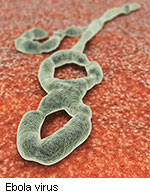- Skip Storing This Everyday Product in the Fridge Door
- Green Tea + B3 Pairing May Boost Brain Health
- Navigating Your Midlife Crisis: Embracing New Possibilities
- City Raccoons Showing Signs of Domestication
- Mapping the Exposome: Science Broadens Focus to Environmental Disease Triggers
- One Week Less on Social Media Linked to Better Mental Health
- Your Brain Changes in Stages as You Age, Study Finds
- Some Suicide Victims Show No Typical Warning Signs, Study Finds
- ByHeart Formula Faces Lawsuits After Babies Sickened With Botulism
- Switch to Vegan Diet Could Cut Your Greenhouse Gas Emissions in Half
First Ebola Vaccine Could Be Less Than a Year Away, Scientist Says


A vaccine for the deadly Ebola virus could become a reality in less than a year, one expert says.
As the death toll in the Ebola outbreak in West Africa nears 1,000, several groups of scientists are racing to produce a vaccine to protect against the disease. And the developer of one of these potential vaccines claims it could be ready for human use in six to 10 months with additional funding.
Matthias Schnell, director of the Jefferson Vaccine Center at Thomas Jefferson University in Philadelphia, explained that the vaccine he is developing with researchers from the U.S. National Institutes of Health is based on a human rabies vaccine.
By attaching Ebola to the rabies virus, Schnell’s group was able to make a vaccine that may protect against both Ebola and rabies.
“How effective it will be in humans is hard to predict,” he said. “The rabies vaccine works well in humans, but for any vaccine you have to put it in humans and see if they develop antibodies without getting sick.”
Schnell’s vaccine triggers the immune system to produce antibodies against three strains of Ebola.
The vaccine contains the Zaire strain of Ebola that is currently spreading in West Africa, but it also includes the Sudan strain of Ebola and the Marburg virus, which is in the same family as Ebola and causes a similar disease.
So far, the vaccine has only been tested in monkeys, where it was found to protect against the Zaire Ebola virus.
Before the vaccine could be available, it would have to be tested in humans to be sure it is safe and effective. That process would typically take as long as three years, Schnell said.
The hurdle to getting trials started is funding, he said. If more money was available, a vaccine could be ready by next year, he said.
Experts were cautious about the potential of the vaccine.
“This vaccine hasn’t been tested in humans, so it’s impossible to say what its potential is,” said Dr. Sunil Kumar Sood, a pediatric infectious disease specialist at Southside Hospital in Bay Shore, N.Y.
“Many vaccines make it through early trials, but then don’t make it beyond that because they don’t produce enough antibodies or aren’t tolerated by humans,” Sood explained.
Schnell said they chose to base their vaccine on a rabies vaccine, because while Ebola outbreaks only occur sporadically, rabies is always around, so the vaccine could be used more widely.
Dr. Ambreen Khalil, an infectious diseases specialist at Staten Island University Hospital in New York City, said, “This vaccine is promising, but won’t help people already infected.”
That is why Schnell is also involved in developing a treatment that would produce large amounts of Ebola antibodies that could be given to patients suffering from the disease.
Although this treatment isn’t long-lasting and does not confer the immunity of a vaccine, antibodies could help remove the virus from the blood before more cells are infected, Schnell explained.
Moreover, it gives the immune system time to build a response to the virus, he noted.
Schnell is working on producing human-like antibodies in cows. By vaccinating cows with the new vaccine, Schnell hopes to be able to produce large amounts of serum that will cure people with Ebola. Each cow could produce as many as 2,000 doses every two weeks.
Again, money is the main obstacle to making this potential treatment a reality, he said. If funding were available, the treatment could be ready for human testing in as little as four to six months, Schnell said.
The experimental drug ZMapp, used to treat two Americans infected with Ebola, Dr. Kent Brantly and Nancy Writebol, used a similar approach. However, the supply of the drug is very limited at this time, Schnell noted.
Thomas Geisbert, a professor of microbiology and immunology at the University of Texas Medical Branch in Galveston, said, “It looks like the antibody is an alternative to ZMapp. We may never know whether or not the administration of ZMapp was the actual reason that the two Americans appear to be recovering from Ebola, but ZMapp has clearly been shown to protect nonhuman primates against Ebola when given after exposure.”
“Given that ZMapp already has nonhuman primate data and is likely close to beginning clinical trials — it is hard to imagine how that would not be pushed now — I am not really sure where Schnell’s work fits in. The concept of providing protection against multiple strains and species of hemorrhagic fever is, of course, important,” Geisbert said.
More information
Visit the U.S. Centers for Disease Control and Prevention for more on the Ebola virus.
Source: HealthDay
Copyright © 2025 HealthDay. All rights reserved.










